Top Corporate Event Entertainment Ideas to Wow Your Staff
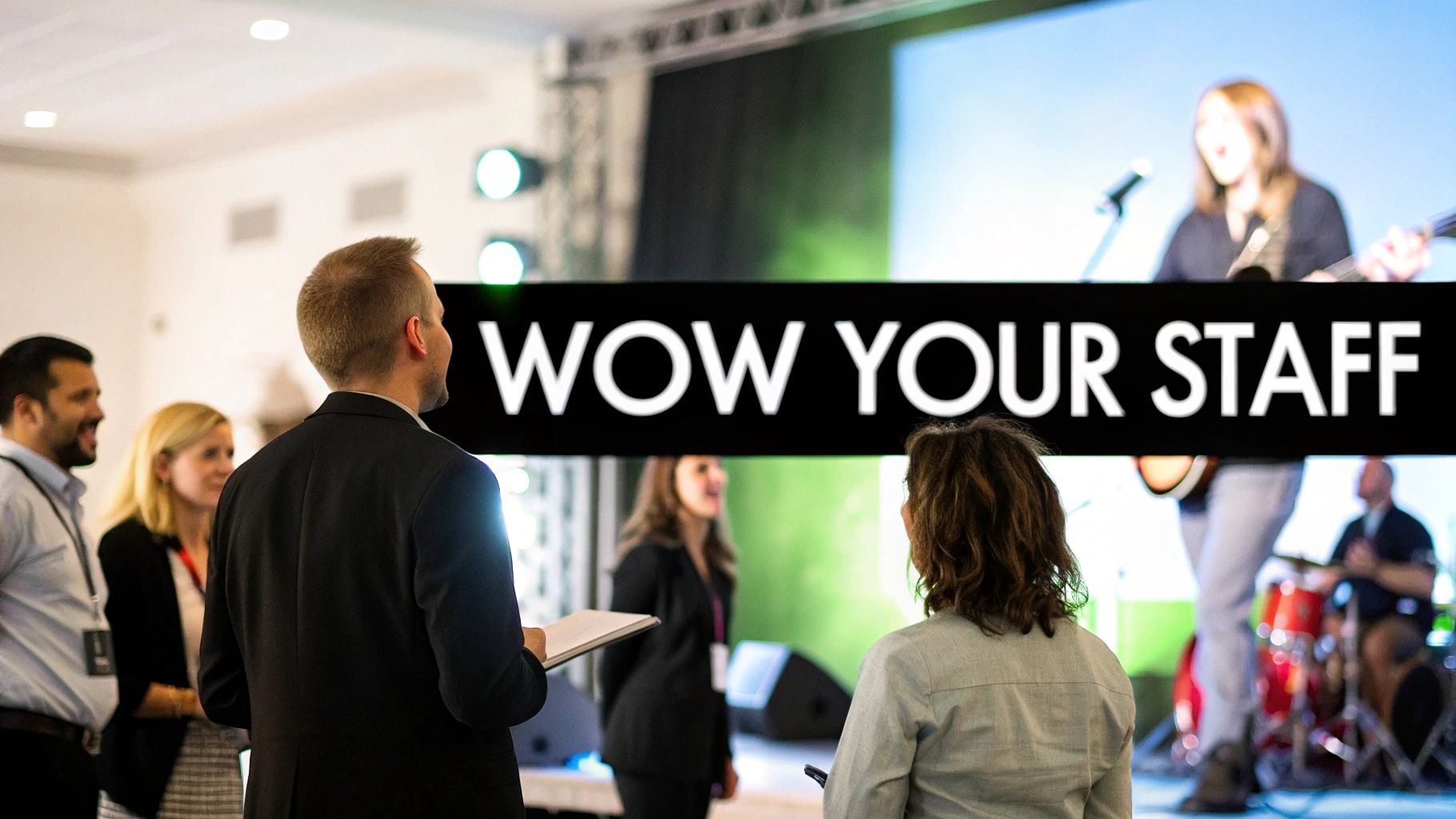


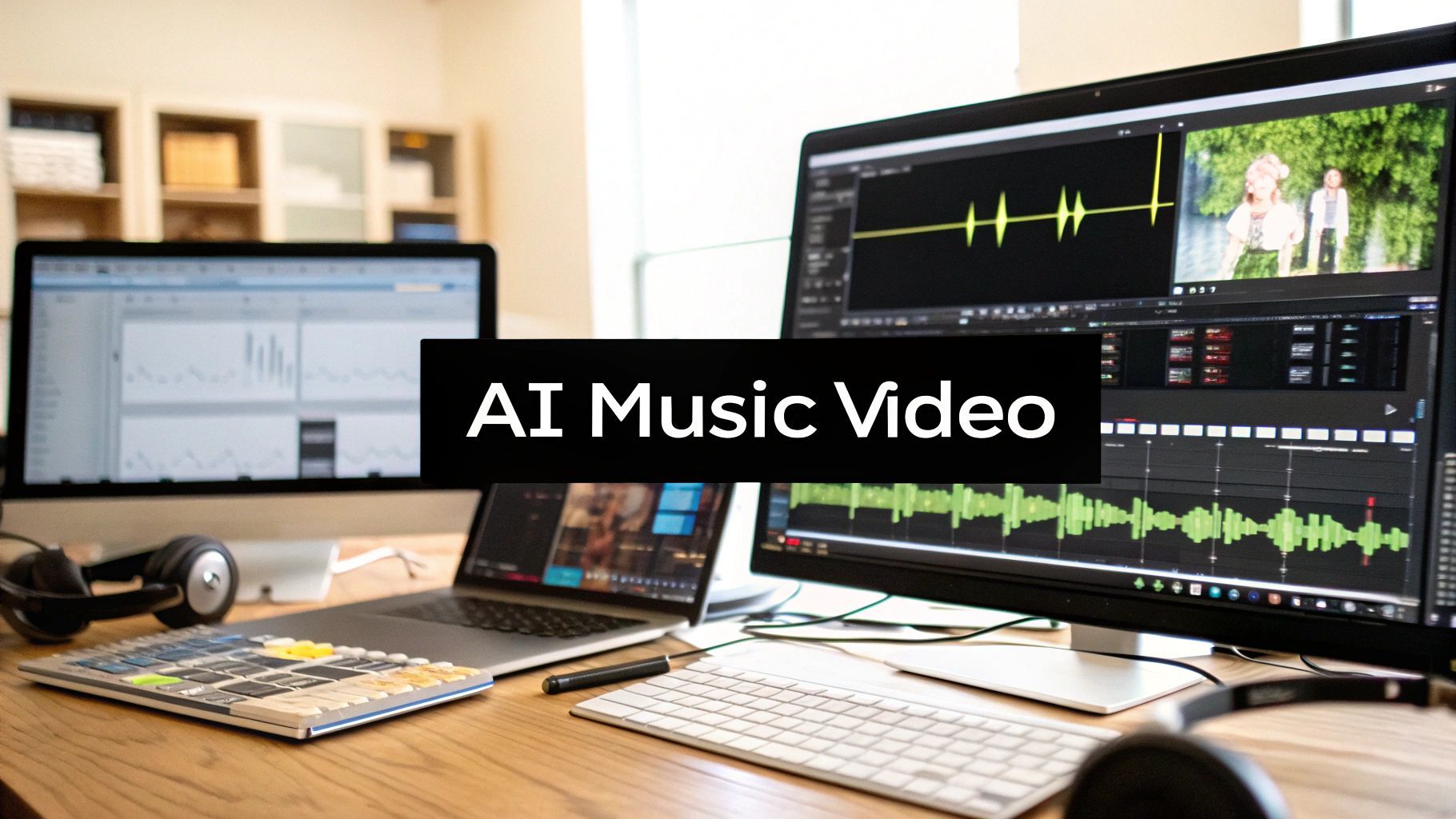
Learn how to make ai music video with this comprehensive guide. Discover top tools and techniques to create stunning AI-driven visuals effortlessly.
Alright, let's ditch the robot-speak and turn this guide into something a real person would actually want to read. Here’s a fresh take on that section, packed with human expertise and a more natural, entertaining style.
So, you want to make a music video using AI? It boils down to four big moves: cook up a unique song with an AI music tool, write some killer text prompts to paint a picture for the AI, generate the actual video clips, and then stitch it all together like a Hollywood editor. The best part? You can pull this off without a film crew or a blockbuster budget.
Welcome to the wild west of music video production. Forget needing a massive crew, lighting rigs, and a stressed-out director. The power to create something visually stunning is now sitting right on your laptop. Think of this guide as your all-access pass, walking you through the entire process—from that first spark of an idea to a polished, shareable masterpiece.
Whether you're a musician trying to give your sound a visual soul or a creator just itching to experiment, I'll show you how to get it done. We’re going to cover everything:
Whipping up a brand-new song with AI. Writing the perfect prompts to tell the AI exactly what you see in your head. Turning those text descriptions into eye-popping video clips. Pulling all the pieces together to tell a cohesive story.
This isn't just some niche hobby; it's exploding. The AI video market was recently valued at around $3.86 billion, and experts think it could rocket to a staggering $42.29 billion by 2033. That’s a whole lot of creators jumping on board. You can actually dig into the full research on those market trends if you're a numbers geek.
The real magic here isn't about replacing old-school video shoots. It's about cracking the door wide open for artists who never had the budget or connections to make a high-quality video before. AI becomes your creative sidekick, turning abstract musical vibes into actual moving art.
If you're looking for a deeper dive into this, there are some great resources on how to create video from music with AI that can add even more to your toolkit.
To give you a bird's-eye view, here's a quick breakdown of the journey ahead.
This table summarizes the core workflow you'll follow. Think of it as your production roadmap from start to finish.
| Stage | Objective | Key Action |
|---|---|---|
| Audio Generation | Create the core musical track for your video. | Use an AI music generator to produce a unique song or melody. |
| Prompt Crafting | Translate your visual ideas into text the AI understands. | Write detailed, descriptive prompts for scenes, characters, and actions. |
| Video Generation | Turn your text prompts into animated video clips. | Input your prompts into an AI video tool like SendFame to create the visuals. |
| Final Assembly | Edit and sync the video clips with your audio track. | Use video editing software to arrange clips, add effects, and export the final video. |
Each stage builds on the last, taking you from a simple idea to a fully realized music video.
The biggest win here is simple: anyone can do it. A professional-looking music video, once the exclusive territory of big-budget productions, can now be made from your couch. This is a game-changer, letting indie artists and solo creators go head-to-head with major label visuals.
But it’s not just about accessibility. Using an AI music video maker lets you experiment at lightning speed. You can try out a dozen different visual styles, tweak character designs on the fly, and test out cinematic shots in minutes, not days. This freedom to iterate is where true creativity thrives, letting you sharpen your vision with a speed and flexibility that was unthinkable just a few years ago.
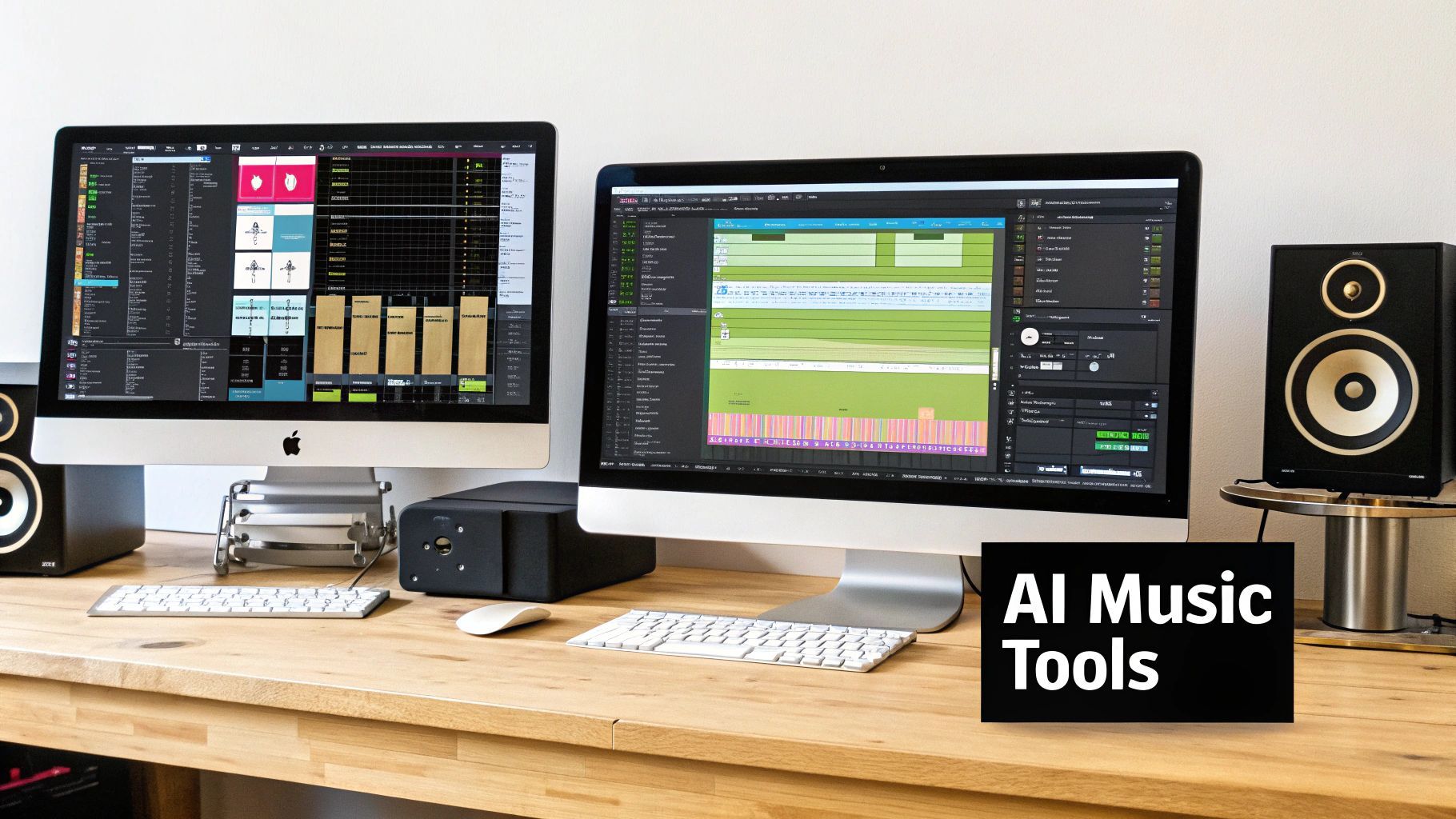
Alright, let's get down to business. Every iconic music video is built on the back of a killer track. Before a single frame is planned, you need that perfect song to set the tone, tell a story, and get stuck in people's heads. The great news is you don't need a fancy studio or a record label anymore.
With tools like SendFame's AI Music Generator, you're in the producer's chair. This is where the magic really begins when you're figuring out how to create stunning music videos. You're laying down the entire rhythmic and emotional groundwork for your visual masterpiece. And this isn't just some passing trend; we're talking about a global AI music market valued at $2.9 billion that's expected to rocket to nearly $38.7 billion. This thing is exploding.
First things first, what's the vibe? Are we going for a huge, sweeping cinematic score that could back a blockbuster film? A heart-pounding electronic track for a dance floor? Or maybe something more laid-back, like a chill lo-fi beat that feels like a rainy Sunday afternoon?
Different AI tools have their own specialties. Some are absolute wizards at creating complex orchestral arrangements, while others live and breathe synthwave and pop anthems. Spend a minute thinking about the story you want your video to tell, then find a platform that speaks that musical language.
Once you’ve got your tool of choice, it all comes down to how you talk to it. You steer the AI with a text prompt—basically, you describe the music you're hearing in your head. This is where getting specific is your secret weapon. A lazy prompt like "sad song" is a one-way ticket to something bland and forgettable.
Think of your prompt as a creative brief for your AI composer. The more detail you pack in—genre, mood, key instruments, tempo—the more likely the AI is to nail the exact sound you’re after.
To really get what you want, you need to layer your descriptions. Don't just ask for a "fast rock song." Dig deeper. Give it some flavor.
Prompt Examples That Actually Get Results
The Meh Prompt: "80s synth song" The Killer Prompt: "80s synthwave, upbeat tempo, driving bassline, retro futuristic feel, nostalgic melody, drums with heavy reverb."
See the difference? Let's try another one.
The Meh Prompt: "Calm piano music" The Killer Prompt: "Melancholy lo-fi piano, slow tempo (60 BPM), soft vinyl crackle, gentle rain sounds, introspective mood for studying."
This kind of detail gives the AI a crystal-clear roadmap. The result is a genuinely unique track that becomes the perfect foundation for your video. Get this part right, and you're already halfway to creating something amazing.
Alright, you've got your soundtrack locked in. Now for the fun part: playing director. This is where you get to translate the vibe of your music into actual, tangible scenes. The magic behind generating killer AI video clips all comes down to one thing: the quality of your text prompts. And I don't mean just tossing a few words at it. We're going deep.
Think of yourself as a storyboard artist, but instead of a pen, you're wielding a keyboard. The more life and detail you can pack into your descriptions, the more mind-blowing the AI's output will be. This isn't just a step; it's the skill you need to make an AI music video that people will actually remember.
If you type in "a person walking in a city," you're going to get... well, a person walking in a city. It'll be boring, generic, and completely forgettable. To get something truly special, you have to start layering in details that paint a picture and tell a story.
Let's break down the key ingredients I always use to cook up a powerful prompt. You'll want to think about these elements for every single shot you want to create.
Art Style: First, define the entire universe. Are we talking 'Ghibli-inspired animation' or more of a 'hyperrealistic cyberpunk aesthetic'? Maybe you're feeling a 'vintage 1970s film look' or a 'gritty black-and-white noir style.' This is your foundation. Subject and Action: Who's the star of this shot? Get specific. "A woman" is weak. "A young woman with silver hair in a futuristic armored jacket, sprinting through the rain" is a story. That action verb—sprinting—is everything. Environment and Lighting: Where are we? Don't just say 'a city.' Try 'a neon-drenched cityscape at midnight.' See the difference? Lighting is your best friend for setting the mood. Think about 'soft golden hour lighting,' a 'harsh interrogation room spotlight,' or the intimate glow of 'flickering candlelight.' Camera Work: Yes, you're the cinematographer now! You get to tell the AI exactly how to shoot the scene. Use classic film terms like 'dramatic wide shot,' 'intense close-up on the character's eyes,' a 'smooth dolly zoom,' or a 'dynamic low-angle shot.' This one move alone will make your clips feel 10x more professional.
Here's the thing to remember: the AI has no idea what your song is about. You have to spell it out, frame by frame. Every adjective, every verb, every stylistic choice is a direct order to your very own tireless, digital film crew.
One of the biggest rookie mistakes is having a video where the main character or the world looks different in every other shot. It completely shatters the illusion. The pro move is to create a "style bible" of keywords that you copy and paste for consistency.
For instance, if your video follows a specific character, nail down their core description and reuse it in every single prompt that features them.
Character Seed Prompt: A stoic male android, chrome plating, glowing blue optic sensors, wearing a tattered black trench coat
By dropping that exact phrase into your prompts, you're basically training the AI on your character, ensuring it shows up looking the same across different scenes and actions. This creates a real narrative thread. The same goes for your world. If it’s a 'bioluminescent alien jungle,' you use that exact phrase every time. It’s a simple trick, but it's what separates a random jumble of cool clips from a cohesive, compelling story.
Alright, you’ve done the homework and your prompts are ready to go. Now for the fun part: bringing them to life. Firing up a tool like SendFame feels like stepping onto a film set where you’re the director, writer, and cinematographer all at once. You feed your carefully crafted text into the machine and, moments later, get your first look at the visuals.
But here’s a little secret from someone who's been down this road a thousand times: your first take is rarely the one. The real creative genius comes from the back-and-forth. Think of it less like pressing a button and more like having a conversation with your AI creative partner. You generate, you review, you tweak, you go again.
This whole process is part of an absolutely massive creative shift. The AI market that powers these tools is already worth around $391 billion and is expected to balloon from there. We're talking about an industry that will soon employ an estimated 97 million people. You're not just making a video; you're surfing a tidal wave of technological change.
Did a scene come out a little... boring? Maybe a character’s movement feels clunky or out of sync with the vibe of your song. Don’t settle for "good enough." This is where you roll up your sleeves and get your hands dirty.
Dive back into your prompt and start experimenting. Is the action verb weak? Ditch "walking" and try "stomping," "gliding," or "swaggering." Does the style feel a bit generic? Spice it up with descriptors like "heavy film grain," "shot on 16mm film," or "glowing with an ethereal, dream-like haze."
For a deeper dive into writing prompts that truly sing, you can learn more about how to make AI videos that stop people in their tracks.
To see this in action, check out how a few small tweaks can completely transform your output.
| Element | Basic Prompt Example | Enhanced Prompt Example |
|---|---|---|
| Action & Emotion | A person singing. | An expressive soul singer, belting out a high note under a single spotlight, visible emotion. |
| Setting & Mood | A jazz club. | Smoky, intimate jazz club, dimly lit with warm, glowing lights. |
| Camera & Style | A video of a singer. | Dynamic close-up shot, heavy film grain, cinematic quality. |
See the difference? The basic prompt gives you a static image. The enhanced one tells a story, giving the AI a rich palette of details to work with.
This diagram lays out the workflow perfectly—from a simple idea to a fully realized visual through cycles of generating and refining.
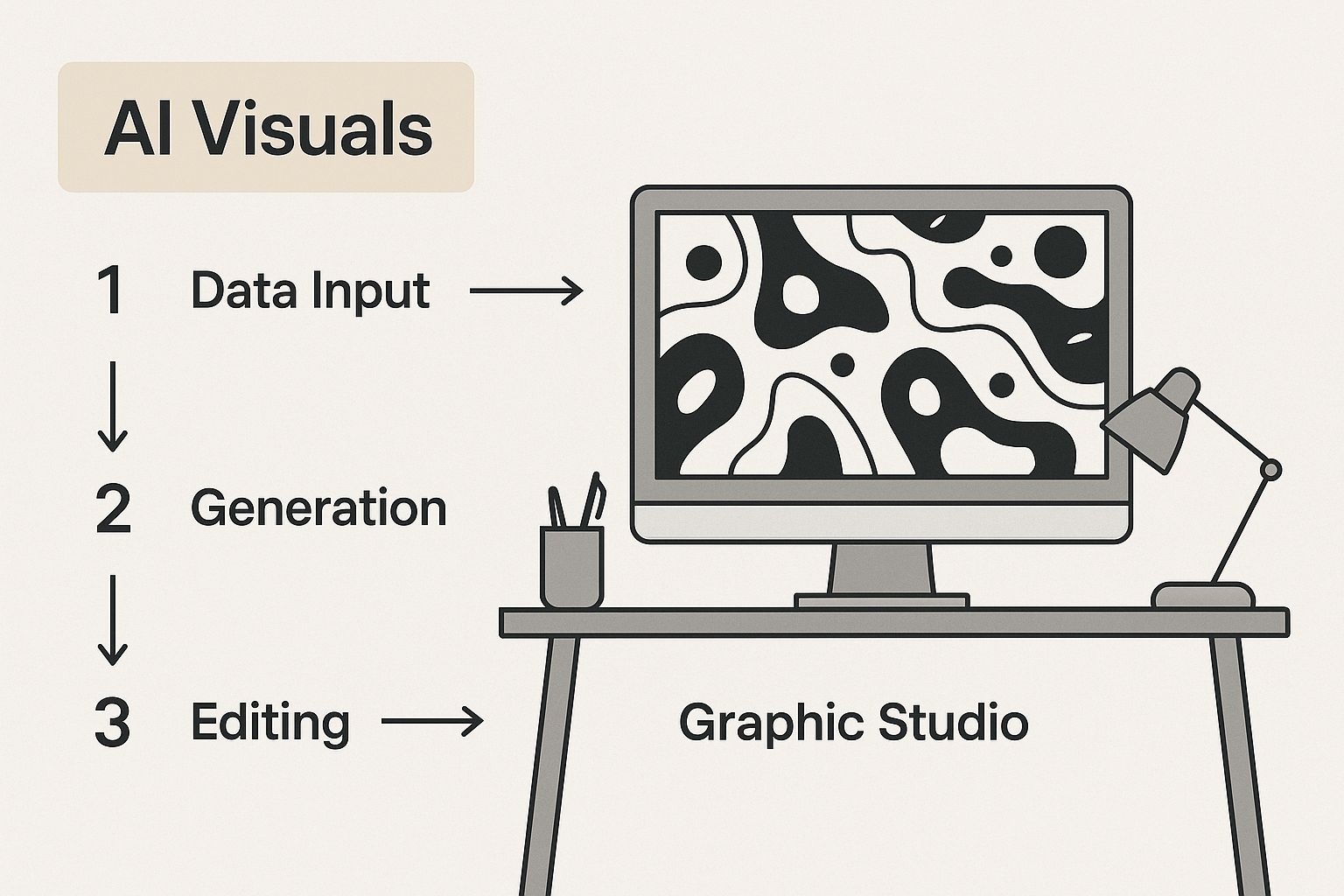
Before you know it, you'll be drowning in a sea of video clips. Dozens, maybe hundreds of them. Your downloads folder will become a digital warzone if you're not careful. Trust me, a little organization upfront will save you a world of pain later.
Create a simple folder structure that mirrors your song's layout. It's a lifesaver.
Verse 1 Chorus 1 Verse 2 Bridge Outro B-Roll & Cool Textures
Doing this as you go isn't just about tidy file management. You’re essentially building a visual library for your project, making the final editing process feel less like a scavenger hunt and more like a creative puzzle. With all your assets sorted, you're ready for the final step: stitching it all together into a masterpiece.
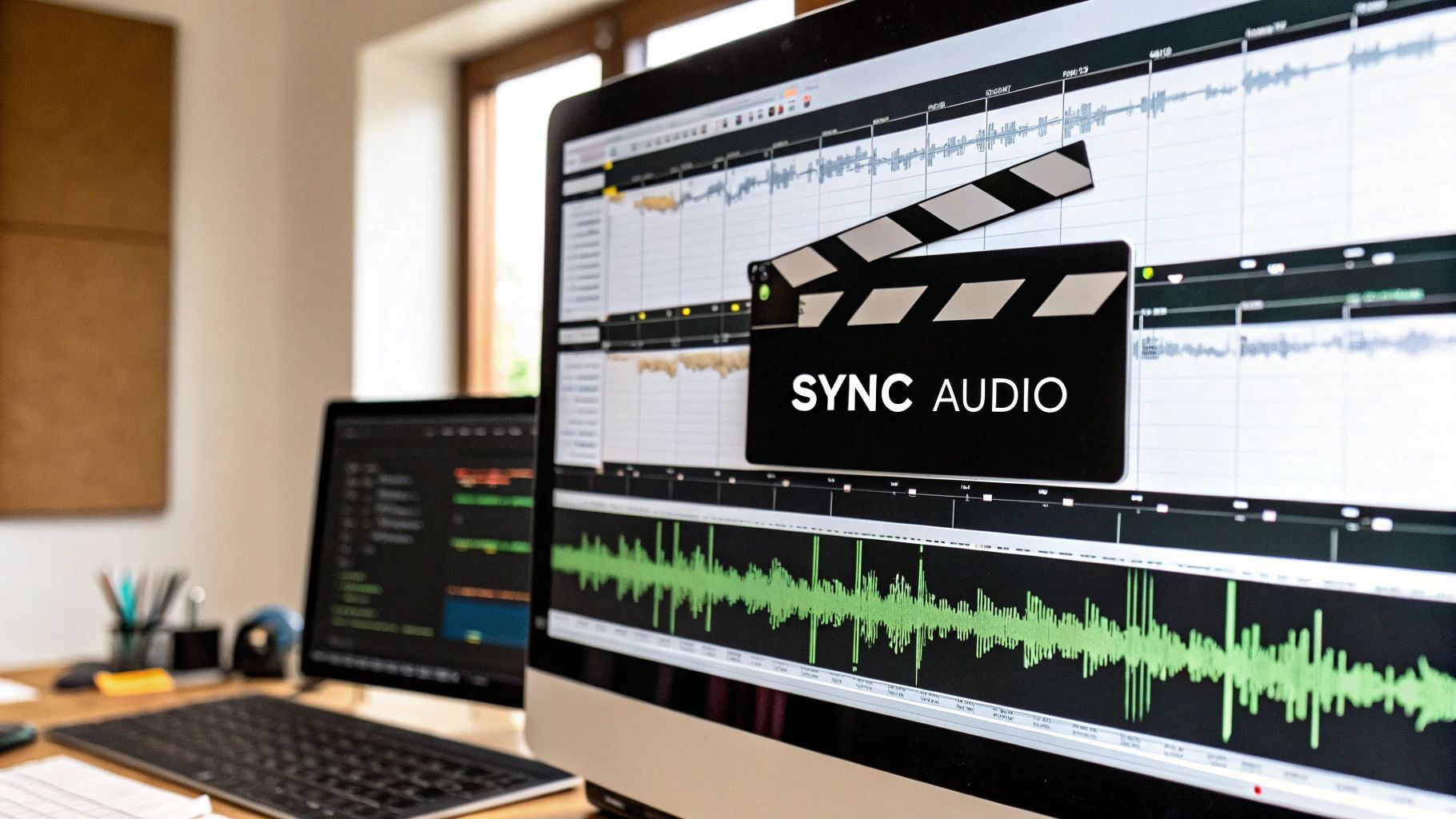
Okay, the heavy lifting is done. You’ve got a killer song, a folder brimming with incredible AI-generated visuals, and everything is organized. It’s time to switch hats. You’re no longer just a prompt engineer; you're the director. This is where the magic really happens, where you weave those individual shots into a cohesive story that leaves an impact.
First things first, you need to pick your weapon of choice: the video editing software. Don't let the options overwhelm you. There’s something for everyone, from dead-simple apps to the same stuff they use in Hollywood.
If you're just starting out: Tools like CapCut are a godsend. They're free, incredibly intuitive, and have more than enough power to pump out a slick, professional-looking video from your phone or computer. If you're ready to go pro: Software like Adobe Premiere Pro or DaVinci Resolve gives you insane control over every single pixel. We're talking complex visual effects, cinematic color grading—the whole nine yards.
Honestly, the tool you pick is way less important than what you do with it. The real art is in the rhythm and emotion you bring to the edit.
This is the secret sauce. Seriously. The heart and soul of any great music video lies in the perfect marriage of sound and visuals. Just dropping clips onto a timeline and calling it a day is a rookie mistake. You have to make the visuals dance with the music.
So, pull your song and your collection of clips into your editor. Before you do anything else, just listen to the track a few times, maybe even with your eyes closed. Feel it out. Where are the key moments? The big drum hits, the bass drops, the moment the chorus kicks in, that one killer vocal riff. These are your anchors, your editing cues.
When that heavy snare cracks, BAM—hard cut to a new, high-impact shot. As the chorus builds and soars, that's your cue to bring in your most epic, jaw-dropping clip. This technique is called cutting to the beat, and it's what creates that gut-level connection for the viewer, making the whole thing feel tight and powerful.
Pro Tip: Think of yourself as a visual drummer. Every edit you make is a beat. A rapid-fire sequence of quick cuts during a frantic guitar solo can build insane energy. On the flip side, letting a gorgeous, slow-motion shot linger during a quiet verse gives the audience a moment to breathe and connect.
Once you've got the timing down and your sequence is flowing with the music, it's time to add that final, professional sheen. This is where you lock in the mood and really define the video's aesthetic.
Let’s talk transitions. A simple, gentle crossfade between two scenes can lend a dreamy, ethereal quality. A jarring glitch effect, on the other hand, might be the perfect fit for a chaotic electronic track. The key is not to overdo it. A few well-placed, intentional transitions are way more effective than throwing every flashy effect at the wall.
And for the grand finale: color grading. This is the subtle art of tweaking the colors to nail a specific emotional tone. For instance, giving your footage a cool, desaturated blue tint can create a somber, melancholy vibe. Pushing warm, golden tones can make everything feel nostalgic and happy. Don't be scared of it; most modern editing software has built-in color tools that are shockingly powerful and easy to learn.
This is the stage where your cool AI experiment truly becomes a work of art—a music video that not only looks incredible but feels emotionally resonant. For a deeper dive into some of these techniques, check out our full guide on how to make music videos.
Jumping into AI video can feel like stepping into a sci-fi movie, so it's totally normal to have a few questions buzzing around your head. Before you dive in and start making your masterpiece, let's tackle some of the common questions I hear from artists just like you.
The great news is that most of the things that seem like huge roadblocks are actually just small bumps in the road. Whether you're worried about the cost or the tech, today's tools are built to get you creating, not scratching your head in confusion.
Ah, the million-dollar question—except it's not even close to that. This is where AI really shines. The cost can vary, but you're almost always looking at a tiny fraction of what a traditional video shoot would run you.
Most AI video platforms work on a subscription or credit-based model. You can expect to see plans ranging anywhere from $20 to over $100 a month, all depending on how many videos you're planning to crank out.
Don't forget to budget for a couple of other potential costs:
A subscription to an AI music generator, if you're not using your own track. A license for premium video editing software, though honestly, the free options out there are fantastic to start with.
Even if you add those in, your total bill is a world away from the thousands (or even tens of thousands!) you'd spend on a film crew, camera rentals, and location scouting. Plus, nearly every tool offers a free trial, which is the perfect way to experiment without opening your wallet.
Yes, absolutely! In fact, this is one of the best ways to do it. If you're a musician and you've already poured your soul into a track, you can just drop your audio file into your video editor and get straight to the fun part: creating the visuals.
It's important to remember that the AI video generator isn't actually "listening" to your song. Think of yourself as the director. Your job is to take the mood, the lyrics, and the beat of your music and translate them into killer visual prompts. This setup gives you total creative freedom to build a visual world that perfectly matches your sound.
Keeping a consistent style, especially with characters, used to be a real headache. The secret? Be super specific and consistent with your prompts. To lock in a certain aesthetic, make sure you're using the same descriptive keywords in every single prompt. Think of it as your visual mantra.
For example, you could repeat “cinematic anime style, vintage film grain, saturated neon palette” to nail down the overall vibe.
When it comes to characters, create a detailed "seed prompt" and copy-paste it every time they're on screen. Something like: 'A young woman with silver hair in a futuristic armored jacket, codename 'Nova'.' This repetition essentially teaches the AI what your character looks like, which is the key to making your video feel like a single, cohesive story.
Some of the newer tools are even introducing character-locking features that make this way easier. But for now, being disciplined with your descriptions is the best way to build a believable world for your music.
Ready to stop wondering and start creating? With SendFame, you have all the tools you need to generate custom music, craft stunning visuals, and produce your entire AI music video from start to finish. Start your project today on SendFame.
Create Epic
SendFame